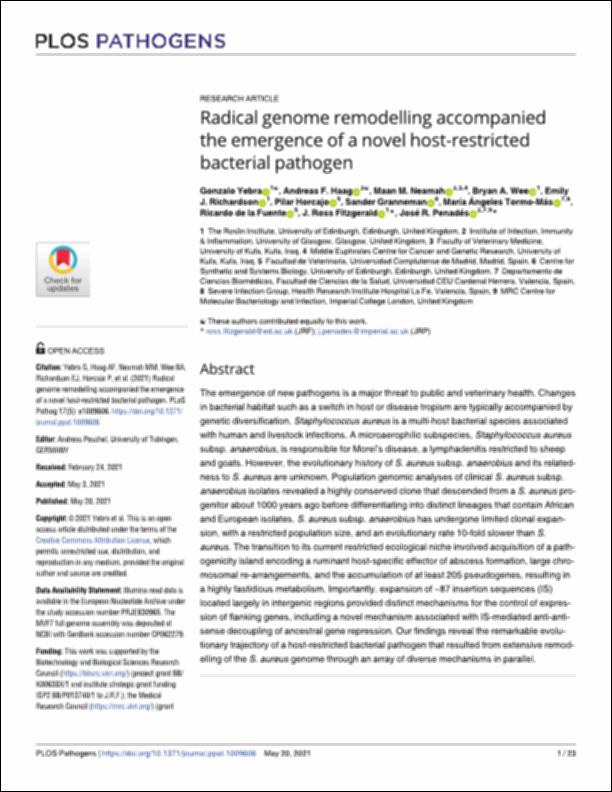Por favor, use este identificador para citar o enlazar este ítem:
http://hdl.handle.net/10637/13688Radical genome remodelling accompanied the emergence of a novel host-restricted bacterial pathogen
| Título : | Radical genome remodelling accompanied the emergence of a novel host-restricted bacterial pathogen |
| Autor : | Yebra, Gonzalo Haag, Andreas F. Neamah, Maan M. Wee, Bryan A. Richardson, Emily J. Horcajo Iglesias, María del Pilar Tormo Más, María Ángeles Penadés Casanova, José Rafael |
| Materias: | Genómica.; Genomics.; Genética evolutiva.; Pathogenic bacteria.; Estafilococos.; Staphylococcus.; Bacterias patógenas.; Evolutionary genetics. |
| Editorial : | PLOS |
| Citación : | Yebra, G., Haag, A.F., Neamah, M.M., Wee, B.A., Richardson, E.J., Horcajo, P. et al. (2021). Radical genome remodelling accompanied the emergence of a novel host-restricted bacterial pathogen. PLoS Pathogens, vol. 17, i. 5 (20 may.), art. e1009606. DOI: https://doi.org/10.1371/journal.ppat.1009606 |
| Resumen : | The emergence of new pathogens is a major threat to public and veterinary health. Changes in bacterial habitat such as a switch in host or disease tropism are typically accompanied by genetic diversification. Staphylococcus aureus is a multi-host bacterial species associated with human and livestock infections. A microaerophilic subspecies, Staphylococcus aureus subsp. anaerobius, is responsible for Morel’s disease, a lymphadenitis restricted to sheep and goats. However, the evolutionary history of S. aureus subsp. anaerobius and its relatedness to S. aureus are unknown. Population genomic analyses of clinical S. aureus subsp. anaerobius isolates revealed a highly conserved clone that descended from a S. aureus progenitor about 1000 years ago before differentiating into distinct lineages that contain African and European isolates. S. aureus subsp. anaerobius has undergone limited clonal expansion, with a restricted population size, and an evolutionary rate 10-fold slower than S. aureus. The transition to its current restricted ecological niche involved acquisition of a pathogenicity island encoding a ruminant host-specific effector of abscess formation, large chromosomal re-arrangements, and the accumulation of at least 205 pseudogenes, resulting in a highly fastidious metabolism. Importantly, expansion of ~87 insertion sequences (IS) located largely in intergenic regions provided distinct mechanisms for the control of expression of flanking genes, including a novel mechanism associated with IS-mediated anti-antisense decoupling of ancestral gene repression. Our findings reveal the remarkable evolutionary trajectory of a host-restricted bacterial pathogen that resulted from extensive remodelling of the S. aureus genome through an array of diverse mechanisms in parallel. |
| Descripción : | Este artículo se encuentra disponible en la página web de la revista en la siguiente URL: https://journals.plos.org/plospathogens/article?id=10.1371/journal.ppat.1009606 En este artículo también participan: Sander Granneman, Ricardo de la Fuente y J. Ross Fitzgerald. |
| URI : | http://hdl.handle.net/10637/13688 |
| Derechos: | http://creativecommons.org/licenses/by/4.0/deed.es |
| ISSN : | 1553-7366 1553-7374 (Electrónico) |
| Fecha de publicación : | 20-may-2021 |
| Centro : | Universidad Cardenal Herrera-CEU |
| Aparece en las colecciones: | Dpto. Ciencias Biomédicas |
Los ítems de DSpace están protegidos por copyright, con todos los derechos reservados, a menos que se indique lo contrario.


